Amorgorama: An Initiative Aimed at Saving the Fishing...
The attention of the global fishing...
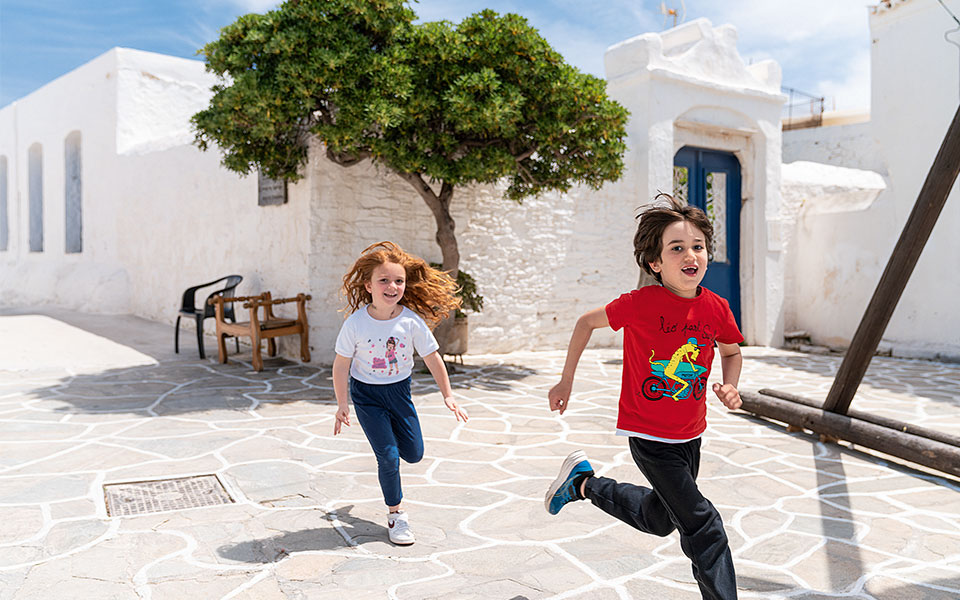
Cycladic light and color: Children enjoying the sunshine in Messaria, the Hora of Kythnos.
© Nicholas Mastoras
On the edge of the Aegean Archipelago there is an island located close to the ports of Attica, but remains quintessentially Cycladic in character. It is small, but large enough to divide its locals into “northerners” and “southerners.” Rocks dominate the landscape, though you will also find almond and fig trees, as well as fertile valleys and livestock farming. It holds a discreet position in our island philology, although its history is dotted with medieval castles, pirates, ancient acropolis’ and remnants of a recent industrial past.
Its indigenous inhabitants call themselves Thermiotes, from the island’s thermal hot springs, while in antiquity they were called Dryopes and the island itself was named after Kythnos, their king. It was never particularly popular with tourists, but, in more recent years, this is radically changing.
Just two hours from Lavrio and three from Piraeus, the affable and welcoming Kythnos – a hidden gem in the Cyclades – offers a glimpse into a rare innocence that, sadly and inevitably, has an expiration date.
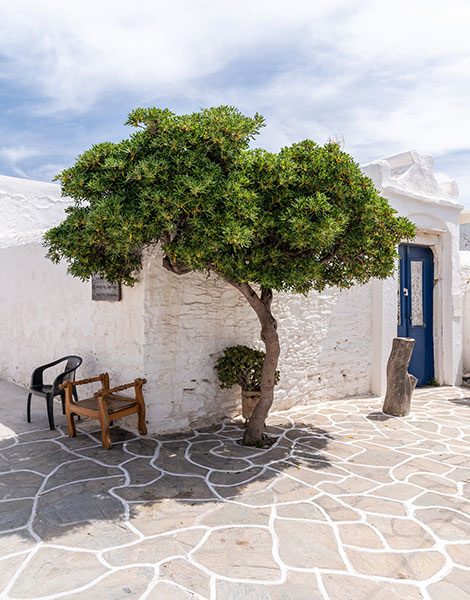
© Nicholas Mastoras
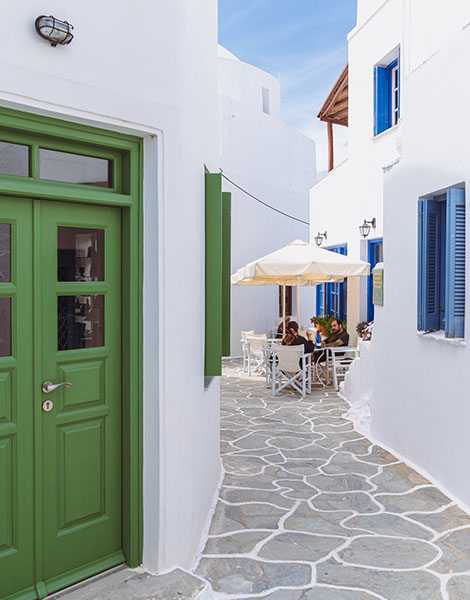
© Nicholas Mastoras
We walk along ancient footpaths, through the wild springtime vegetation and beside the impressively constructed xerolithies (dry stone and mortared walls), these functional yet ornate works dotted along the endless low peaks of the island’s landscape. Here, every spot of land has been cultivated. At the point where the drywalls made to the measure of man are transformed into megalithic structures that appear to have been constructed by giants or demigods, it is clear that we are entering the ruins of an ancient citadel. We are at Vryokastro, and a gigantic stone staircase connects the ancient acropolis with the sea, a stone’s throw from the small island that is practically connected to the coast – Vryokastraki.
In the distance we discern something that brings us back to the present day: a thin strip of sand surrounded by two seas. This is the famous Kolona beach, the backdrop of numerous summer photographs. We observe the small number of boats anchored there, knowing that there will be a veritable fleet here in the summer. We begin our afternoon hike in that direction, taking advantage of the opportunity to admire it empty.
On the way we come across another beach: quiet, long, with tamarisk trees and crystalline waters, that goes by the bizarre name of Apokorousi. Deathly quiet, it seems as if we have come to the end of the world – our guide, Giorgos, informs us that the place is teeming with people in the summer. Thankfully, it is peaceful today, and the large white hull of a traditional boat dominates the view, with two men working onboard. It is a large tourist boat, one of the vessels that transports people from Merihas to Kolona beach.
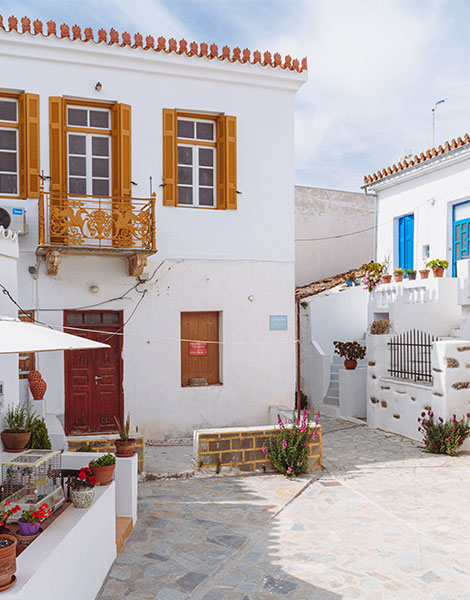
Dryopida
© Nicholas Mastoras
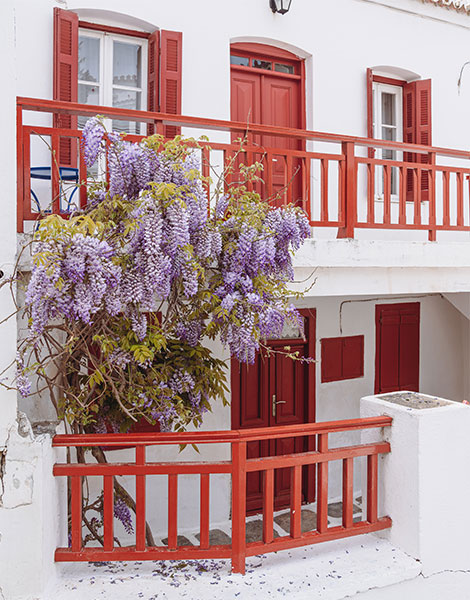
Dryopida
© Nicholas Mastoras
One of the men is Alekos Vitalis, the owner and captain. Further along we spot a varkala, a single-masted yacht with a high stern, also owned by him. “The hull was constructed on Syros,” he informs us. A hull from Hydra, made on Syros, now on a beach on Kythnos: one more unknown adventure of traditional Greek wooden shipbuilding.
We continue our walk towards the quiet setting of Kolona, and the beach bar that is packed with visitors in the summer is empty. We enjoy a glass of wine above this impressive sliver of sand, and soon a speedboat comes to pick us up and take us back to Merihas. The captain is a kind young man and the small vessel skips over the waters that take on mysterious hues in the twilight.
In the evening we visit Messaria – the Hora. Following a small street packed with multicoloured shops and bustling with life, we end up in a small square and at Detzi’s taverna. This welcoming island haven serves delicious local cuisine, our first steps into the gourmet miracle that is the local cheese. We are in a beautiful square that could be anywhere in the Cyclades – in the Hora of Amorgos, Folegandros, or even in the villages of Tinos. The staff is polite and everyone around us is smiling, as if they know they are in a blessed place.
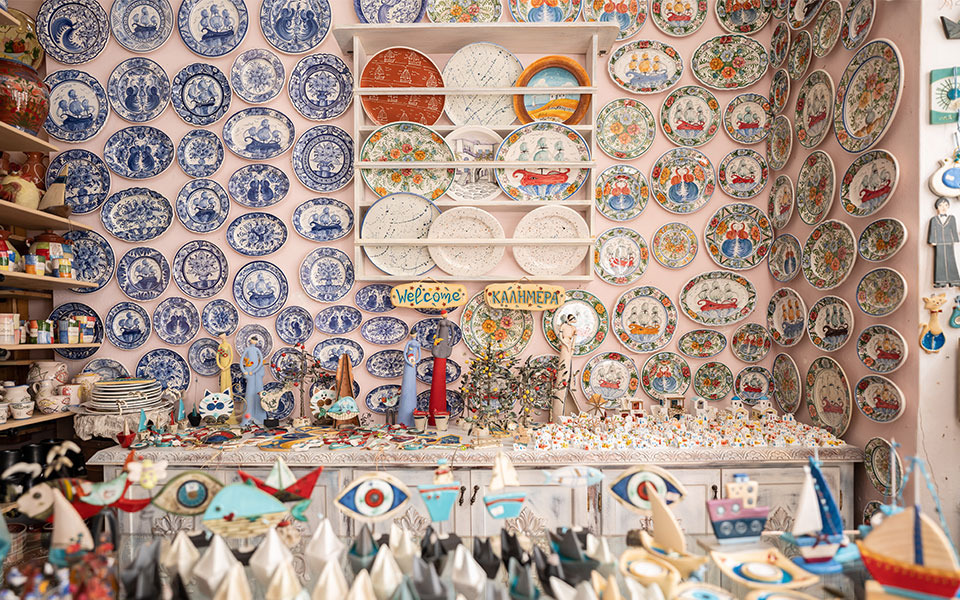
Giorgos Georgoulis’ traditional ceramics workshop-store.
© Nicholas Mastoras
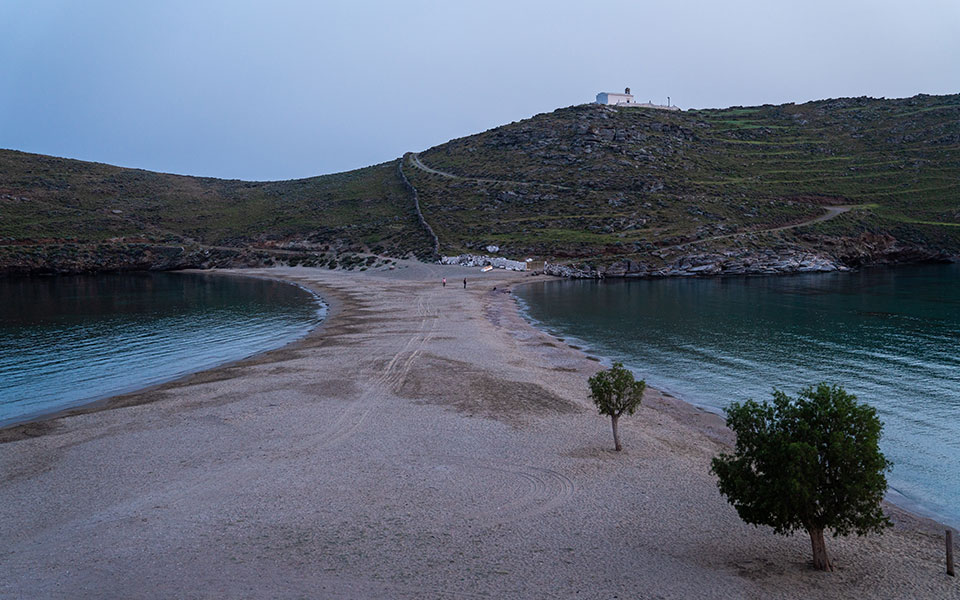
© Nicholas Mastoras
The next morning we continued our exploration in Messaria. In a central spot, next to the chapel of Panagia tou Kastrou with its semi circular steps, a kafenion (traditional coffee shop), a clock tower and a small park with blooming flower pots and the busts of old local benefactors, we can see a two-storey mansion that dominates the landscape. This was the house of Margiora, a powerful woman from Kythnos in the first half of the 20th century, built by her grandfather in 1886. The house has been fortunate enough to see a new, multicolored lease of life in the hands of her great-grandson, architect Fontas Dialismas. With his friend and partner, Michalis Danessis, they converted it into a stylish hangout that serves eclectic food, coffee and cocktails, while also boasting a select wine list and a small delicatessen selling quality local products. Of course, it was named after his great grandmother, and so the legacy of matriarchal figure of Margiora lives on.
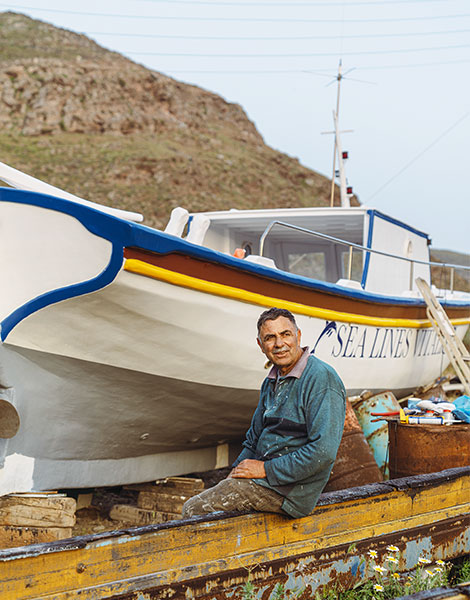
Alekos Vitalis carries out maintenance work on his tourist boat in preparation for the summer season.
© Nicholas Mastoras

At Kythnios Tyros, the traditional cheesemongers in Messaria.
© Nicholas Mastoras
A few meters away, Giannis Paganelis, who worked as a journalist for many years in Athens, was also inspired by his island heritage to return and set up the pastry shop Tratamento, creating exceptional treats. As he enthusiastically tells us about the fine quality ingredients he uses, we gaze around the store that seems to have come from another era; a fairytale in some village somewhere near the open sea. A couple of steps down the road and the art of local gastronomy is replaced by the art of local ceramics. Giorgos Georgoulis continues this tradition with his son Giannis, whom we can see in action working on the potter’s wheel.
This self-designed folkloric museum/workshop is full of wonderful creations of multicolored, hand-painted ceramics. Yet this is not the only local tradition that goes strong: traditional cheesemaking techniques are also being kept alive by the new generation. At the local cheesemongers shop, Kythnios Tyros, we meet two women, Garyfallia Manesi and her sister Filippa, who decided to stay on their island and invest in its local traditions.
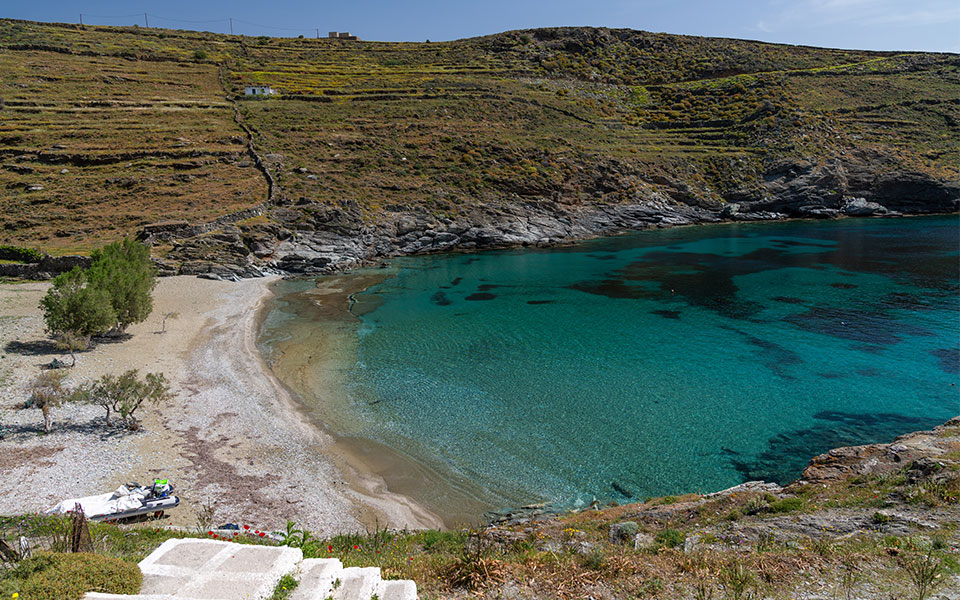
Antonides
© Nicholas Mastoras
Reaching our next destination, Dyopida, we feel the island is growing bigger, almost acquiring two main villages, two sides. This settlement is a cluster of houses with red tile roofs. It does not resemble the stereotypical Cycladic image of Hora, and this is most likely due to the presence of red tiles, brought by the local potters who went to Athens to work in the kilns. But still, we wander around the narrow streets, exploring the twists and turns, small squares and chapels that suddenly appear: Dryopida is a veritable labyrinth. As soon as we enter Katafyki Cave, the warmth of the spring on the brink of summer becomes a refreshing respite.
We can imagine the emotions felt by the locals as they sought refuge here from pirates in ages past, and we can hear the joyous music from the traditional festivals. Remnants of the island’s industrial past can also be found here: one can still see traces of metal ore in the chiseled rocks, and the tunnels unfold into secret passages that we will never know, leading to now abandoned and rusty steps/piers above the sea. The ruins of the main buildings of the old mining company stand in Lefkes as ghosts. They had impressed the locals so much, they were called “spitares” (great houses).
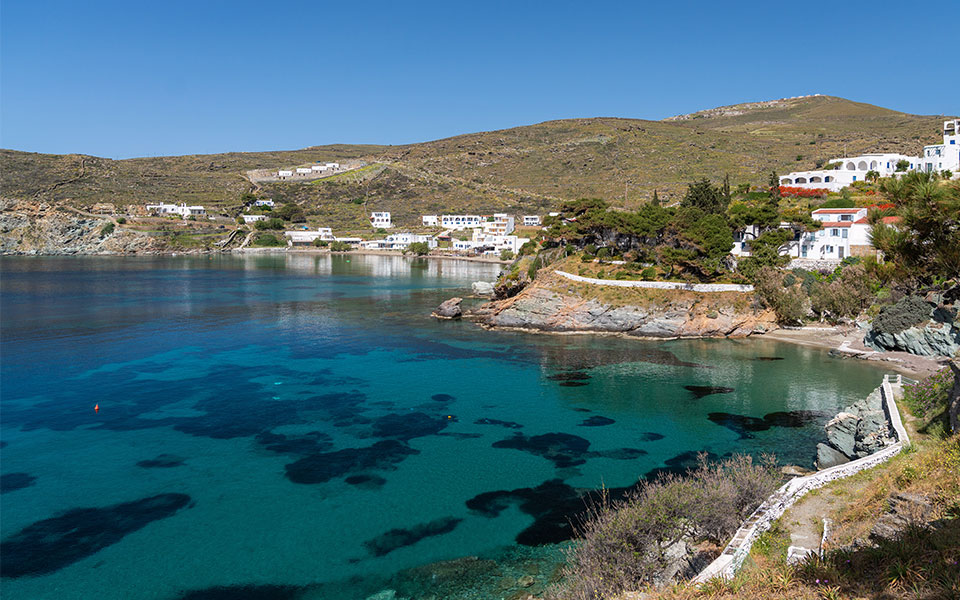
Panagia Kanala Bay
© Nicholas Mastoras
At the little bay of Agia Eirini we come across a microcosm in the early evening, composed of a seafood taverna, a café-bar and a small clothing boutique called Aneme. Its owners, Aria and Nicholas, welcome us to their island kingdom, where the winds do not blow and, as we learn, the sea is packed with moored yachts in the summer. That same evening at a wedding reception at Detzi’s taverna, a singer-violinist and Detzi himself playing the lute, showcase their music loudly, passionately, and with soul. The island songs they play and improvise have a rough quality, something from the old Kythnos that is gradually fading.
The next day, the bright morning sun shines its cheerful rays on the bay of Panagia Kanala, emanating a revitalizing light. A pine tree forest hangs above the crystalline waters, and wandering around the small, peaceful houses of the settlement, we stop at Antonides for a dip, a dreamy beach with the islet Piperi floating in the distance. Later, at the local taverna Archipelagos, we indulge in amazing local cuisine; at Gaidouromantra beach we find another dose of Cycladic exoticism, and in Naoussa we spy the seaside chapel of Agios Ioannis Eleimonas (Saint John the Merciful), standing like a lighthouse on a peninsula, connected to the island via a small cement bridge.
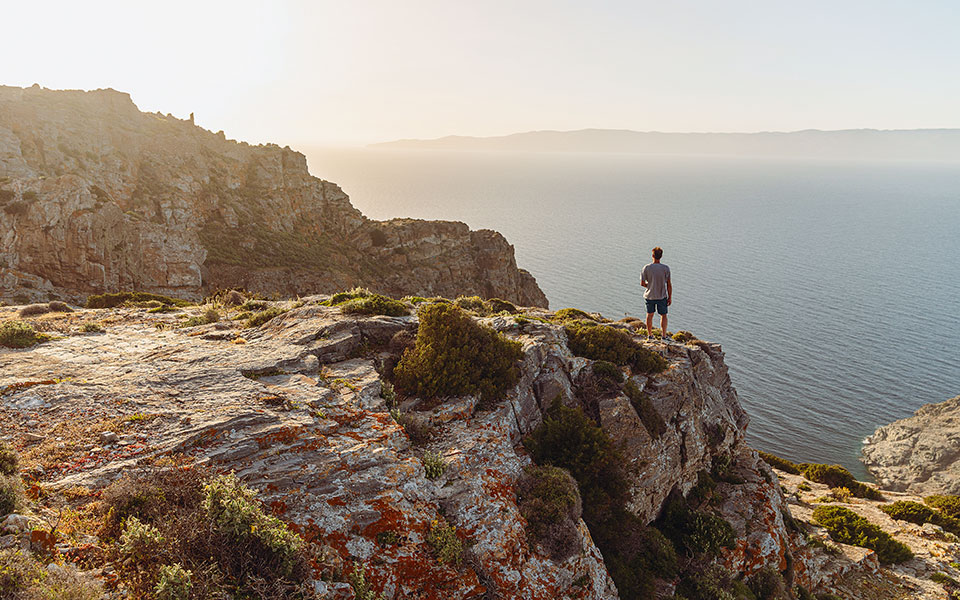
The impressive landscape at Oria, with the ruins of the Venetian castle (left).
© Nicholas Mastoras
All the landscapes of Kythnos are magical, but we never expected what was waiting above, on a windswept cliff in the northern part of the island. There, at the Venetian castle of Oria, an awe-inspiring land evoking medieval mythology awaited. We observe the cliffs falling into the sunset and the Kythnos – Tzia strait with bated breath. Gazing over Sklavos beach, 200 meters below, we imagine stories of knights and seamen from the Middle Ages. Walking as if hypnotized through the ruins of this Venetian town, we cross the remnants of small squares, stores, houses and chapels, packed within the stone walls perched on the island’s peak, floating above the tempests and the ships sailing the blue waters below.
On our last day we visit Loutra, the seaside village known for its hot springs that have been popular since the age of Queen Amalia. The former tourist bath facilities (designed by Hans Christian Hansen and Ernst Schiller) and the Xenia hotel, abandoned for some time now, are being prepared for a second lease of life in the hands of an Israeli businessman. During our discussion in the settlement’s marina he speaks with love about Kythnos where, as he says, he found the old, authentic Greece. Next to us, the sailing yachts come and go non-stop. Loutra and the nearby Agia Eirini have always been refuges for seamen from the wild waters of the Cavo d’Oro.
The following morning, sailing into its gusty, wavy waters, with a crisp northerly wind dancing on the return ferry, it seems as if the castle of Oria is watching our every move. Nestled on the cliffs, it surveys the entire open sea, certain that only those who respect and understand its history will visit it. Stretching out below, Kythnos seems innocent and pure – one of the last paradises in the Aegean.
TRANSPORTATION
Lavrio is the closest port to Kythnos, and the journey (depending on the vessel) can take anything between 1 hour 45 minutes and 2.5 hours (one way ticket, from 10 euros). The journey from Piraeus takes about 3 hours (one way ticket, from 27,50 euros).
Due to its close proximity to Athens (just 25 miles away), many speedboat owners choose Kythnos as their destination for one-day excursions, and sailing trips on yachts during the summer season as often organised – the island’s two marinas (Merihas and Loutra) are frequently used as the first, or last, stop. Lastly, it is connected to many other islands, making it a popular option for island hopping.
ACCOMMODATION
Chora Kythnos Suites (Hora, Tel. (+30) 22810.317.80). A luxury selection, just a 5-minute walk from Hora. Small suites with careful attention to details and Cocomat mattresses. Services on offer include a large hotel swimming pool, fully equipped gym and hearty breakfast. Suites from 230 euros
Kontseta Guesthouse (Merihas, Tel. (+30) 22810.330.24). A traditional guesthouse located high above the port and the marina at Merihas. The rooms are simple and tasteful, with lovely sea views. The guesthouse is run by a particularly welcoming family. Double rooms from 85 euros.
Loukia’s Apartments (Loutra, Tel. (+30) 22810.315.00). The finest “balcony” at Loutra. A family business that offers accommodation in a series of tasteful apartments, just 50 meters from the hot springs and 20 meters from the sea. The Mazaraki tower, the area’s landmark, proudly stands nearby. Double rooms from 50 to 150 euros.
FOOD
Ostria (Merihas, Tel. (+30) 22810.330.17). A seafood taverna on the pier, next to the fishing boats of Merihas. The owner, Manolis, is exceptional on the grill and the service is top notch.
Detzi’s (Hora, Tel. (+30) 22810.312.04). A classic and traditional taverna – grill house in a picturesque square in Hora. Courteous service, good value for money.
Archipelagos (Kanala, Tel. (+30) 22810.323.80). The polite owner of this exceptional taverna, Dimitris Bouritis, selects the finest local ingredients and his mother is an amazing cook. The sfouggato is a must-try, as well as the revithada (chickpea soup) and some of their cheeses, such as trimma and kopanisti.
Katerina (Loutra, Tel. (+30) 22810.314.18). A traditional taverna on a patio with wonderful views towards Loutra. Aria’s (Agia Eirini, tel. 22810-31371, arias.gr). For fresh fish and lobster in the picturesque bay of Agia Eirini.
Margiora (Hora, Tel. (+30) 22810.318.09). A restaurant, wine-cocktail bar and delicatessen in an impeccably renovated mansion in Hora. In the words of its owners: “The wrong recipes for the right ingredients – strictly Cycladic, with a creative twist”.
SHOPPING
Traditional Ceramics, G. Georgouli (Chora, Tel. (+30) 6942.423.325). A veritable “ark” of local ceramic art featuring a large variety of pottery and handcrafted items. Αneme (Agia Eirini, tel. 6945-514540). Small eclectic boutique on the sea, in the bay of Agia Eirini, featuring boho garments and accessories by Greek designers.
Kythnios Tyros (Voudomandra, Hora, Tel. (+30) 22810.317.63). A modern cheese production facility under the management of two young local girls, Garyfallia and Filippa Manesi, that produces the finest dairy products in limited editions. A veritable “temple” to the exceptional cheese produced on Kythnos.
Tratamento (Hora, Tel. (+30) 22810.316.38). A pastry workshop that uses pure local ingredients. Every dessert is a handmade masterpiece. Amazing amygdalota (Greek almond cookies).
ACTIVITIES
Experience Kythnos (Giorgos Vadivoulis, Tel. (+30) 6979.118.996). Excursions, hikes and thematic tours of the island’s landmarks by a young, enthusiastic Thermoit (local), who knows his homeland well.
The attention of the global fishing...
The signature dish of the island...
Discover hidden beaches, authentic tavernas, ancient...
A wild, storied island where the...